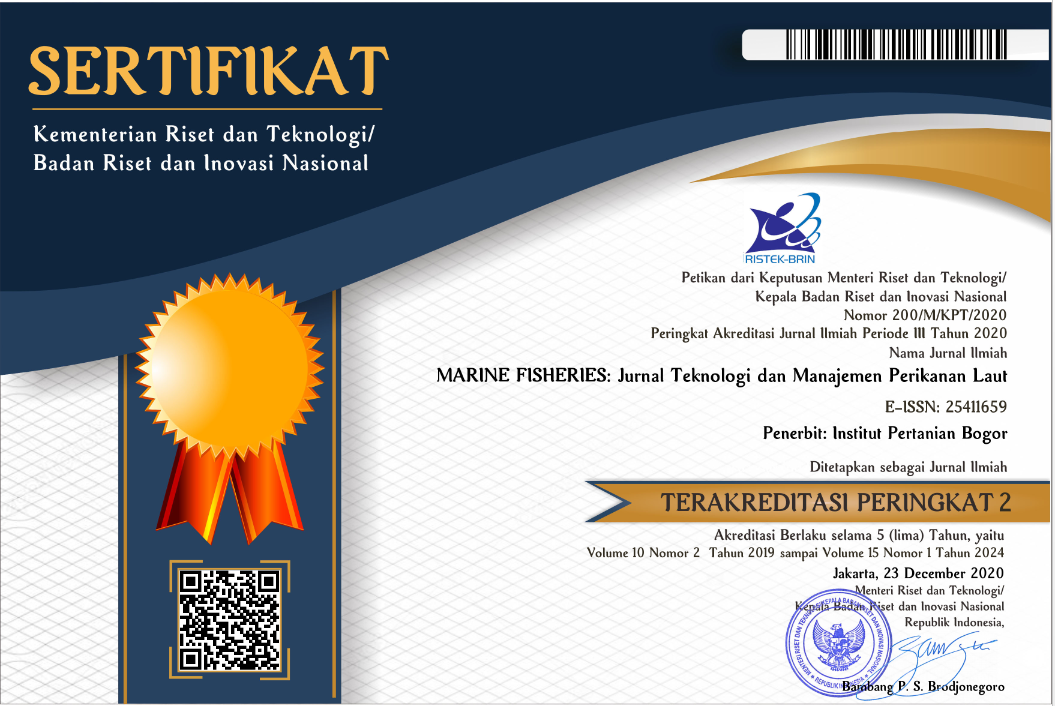RUMPON HIDUP DAN HUBUNGANNYA DENGAN STRUKTUR KOMUNITAS IKAN SECARA SPASIAL-TEMPORAL DI PESISIR KABUPATEN LUWU (BIO-FADs and Its Association with Spatio-Temporal Fish Community Stucture of Cach in Luwu District Coastal Water)
Abstract
ABSTRACT
Biological-Fish Aggregation Devices (Bio FADs) is FADs wich used seaweed or water plants as attractor. FADs live in this study is made using two species of seaweed i.e Eucheuma cottonii and Gracillaria sp. as attractor, so called cottonii FADs or RC and gracillaria FADs or RG. The purpose of this study was to analyze the catches based on its community structures such as the species, abundance, and ecological characteristics spatially and temporally. The research was conducted in Luwu district waters from October 2014-August 2015. RC and RG were installed in three different habitats as an observation station, i.e. river mouth habitat (MS), seagrass habitat (PL), and coral reef habitat (TK). Fish sampling on two types of FADs were collected using a scoop net. Shannon-Wienner diversity index (H') of the three habitats is relatively high. ANOSIM statistical test showed that there is a significance difference of catches abundance between habitats (R = 0.235; p = 0.001). Coral reef habitats have the highest abundance of the catch. Furthermore, there are also highly significant between the months of (R = 0.271; p = 0.001). The highest abundance of fish catches in December. The main species which contribute substantially in the two FADs are Siganus canaliculatus as well as in MS and PL habitat, while in TK habitat the main species is Caranx sp. SIMPER analysis showed that Siganus canaliculatus contribute about 66.42% of the PL habitat.
Keywords: Bio- FADs, diversity index, Siganus canaliculatus
-------
ABSTRAK
Rumpon hidup atau Biological-Fish Aggregation Devices adalah rumpon yang dibuat dengan menggunakan rumput laut atau tanaman air sebagai atraktor. Rumpon hidup pada penelitian ini dibuat dengan menggunakan rumput laut jenis Eucheuma cottonii (RC) dan Gracillaria sp.(RG). Tujuan penelitian ini adalah menganalisis hasil tangkapan ikan berdasarkan jenis, kelimpahan, dan karakteristik ekologis secara spasial dan temporal. Penelitian ini dilaksanakan di perairan Kabupaten Luwu dari bulan Oktober 2014 hingga Agustus 2015. Sampel ikan dikumpulkan dengan menggunakan serok pada kedua jenis rumpon yang dipasang di tiga habitat yang berbeda sebagai stasiun pengamatan. Indeks diversitas Shannon-Wienner (H') secara spasial dan temporal relatif tinggi. Uji statistik ANOSIM menunjukkan bahwa kelimpahan hasil tangkapan ikan antar habitat berbeda sangat nyata, (R = 0,235; p = 0,001). Habitat terumbu karang memiliki kelimpahan hasil tangkapan tertinggi. Selanjutnya secara temporal antar bulan (musim) berbeda sangat nyata (R = 0,271; p = 0,001). Kelimpahan hasil tangkapan ikan tertinggi pada bulan Desember. Analisis SIMPER menunjukkan bahwa Siganus canaliculatus sebagai spesies utama (penciri) pada kedua rumpon, begitu pula dengan dua habitat MS dan PL. Adapun habitat TK, spesies utamanya adalah jenis Caranx sp. Kontsribusi Siganus canaliculatus cukup tinggi pada habitat padang lamun yaitu sebesar 66,42% .
Kata kunci: rumpon hidup, indeks diversitas, Siganus canaliculatus
Downloads
Author(s) who published in this journal agree to following terms:
- Author(s) must understand and agree that the copyright script in published owned by the Marine Fisheries Journal. The copyright includes reproducing and selling the manuscript to all parties.
- Everyone can cite every manuscript published in Marine Fisheries for educational purposes, with the author's name and the Marine Fisheries Journal on reference.









